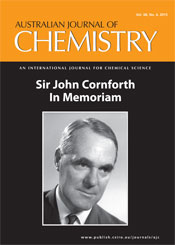
Australian Journal of Chemistry
Volume 68 Number 4 2015
Sir John Cornforth In Memoriam
CH14568Synthetic Amino Acids for Applications in Peptide Ligation–Desulfurization Chemistry
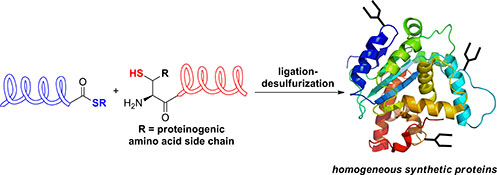
Native chemical ligation followed by desulfurization is a powerful strategy for the chemical synthesis of protein targets. This review focusses on the current synthetic approaches to access amino acid building blocks bearing suitably positioned β-, γ- or δ-thiol ligation auxiliaries that have greatly expanded the scope of the ligation–desulfurization manifold.
CH14600Reflections on the Life and Works of Sir John W. (‘Kappa’) Cornforth
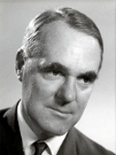
This foreword reflects on the life and works of Sir John (‘Kappa’) Cornforth. It selects publications from various periods in his early years, through wartime efforts at Oxford, and to syntheses of steroids in the laboratory and in nature. It recounts what Kappa thought about some of his own publications and gives a personal opinion of how you can learn about Kappa as a person through the works he published.
CH14543Synthesis of Highly Water-Soluble Adamantyl Phosphoinositide Derivatives
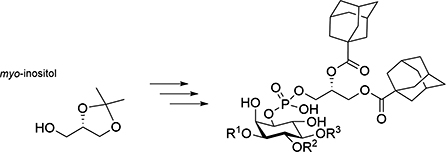
Phosphatidylinositol phosphates are key regulators of cell signalling pathways and membrane trafficking in eukaryotic cells, and there is a need for new chemical probes to further understand how they interact with lipid-binding proteins. Here, the synthesis of phosphatidylinositol phosphate analogues containing adamantyl carboxylic ester groups, in place of the natural lipid side chains, is described.
CH14543 Abstract | CH14543 Full Text | CH14543PDF (489 KB) | CH14543Supplementary Material (1.5 MB) Open Access Article
CH14540Selective Solvent Extraction of Silver(I) by Tris-Pyridyl Tripodal Ligands and X-Ray Structure of a Silver(I) Coordination Polymer Incorporating One Such Ligand
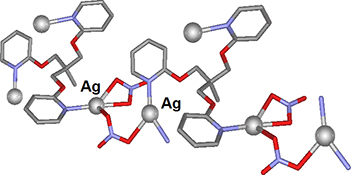
Three flexible tris-pyridyl donor tripodal ligands are shown to exhibit extraction selectivity for silver(i) in competition with six other (industrially important) transition and post-transition metal ions. Further, it has been demonstrated by X-ray crystallography that in one case an unusual ligand-linked two-dimensional coordination polymer is generated.
CH14539Accessing Brominated Natural Product Motifs Using Phosphoramidite Catalysis
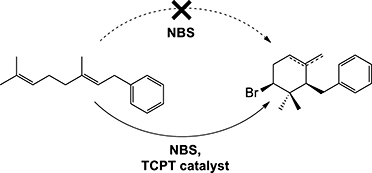
Phosphoramidite catalysis is employed for the bromocarbocyclisation, bromoetherification, and bromoallene-forming reaction of linear precursors. This protocol is complementary to existing methodology.
CH14548An Asymmetric Variant of the Bischler–Möhlau Indole Synthesis
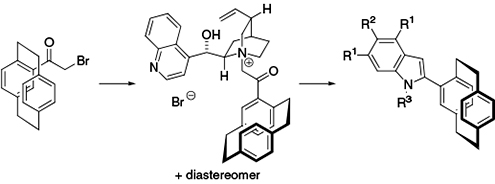
Enantiomerically enriched planar chiral indoles were prepared by an asymmetric variant of the Bischler–Möhlau synthesis. Cinchonine was used as a ‘traceless’ resolving reagent, allowing the formation of readily separable diastereomeric quaternary ammonium salts. These were condensed with several substituted anilines under microwave irradiation; this maximised yield and minimised racemisation.
CH14572Synthesis and DNA-Binding Studies of a Dinuclear Gadolinium(III)–Platinum(II) Complex

This paper reports the synthesis, characterisation, DNA-binding, and in vitro cytotoxicity of a new dinuclear GdIII–PtII complex (1·PF6).
CH14532EXAFS and EPR Studies of the Alkene Oxidation Catalyst Species trans-[CrIII(bpb)(L)2]n+ and CrV Oxidation Products (bpb=N,N'-Bis(2-pyridinecarboxamido)-1,2-benzene)
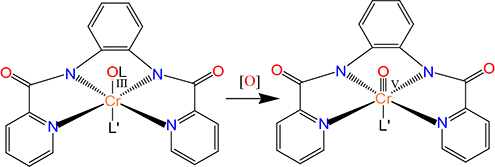
The complexes trans-[CrIII(bpb)(OH2)2]+ and trans-[CrIII(bpb)(OH2)Cl] (bpb = N,N′-bis(2-pyridinecarboxamido)-1,2-benzene) are catalysts in the oxidation of alkenes and the industrially important coupling reaction of epoxides with CO2. Their structures have been determined for the first time by multiple-scattering analysis of their EXAFS and their oxidized CrV analogues by EPR spectroscopy.
CH14574The Conversion of Levoglucosenone into Isolevoglucosenone

Levoglucoseone, a compound that will soon be available in tonne quantities through the pyrolysis of waste paper, has been converted over five operationally simple steps into its quasi-enantiomer isolevoglucoseone. The key step involved was a Wharton rearrangement reaction with the requisite and diastereoisomerically related epoxy-ketones being obtained using electrophilic epoxidation techniques.
CH14590Recent Advances in the Development of Sigma-1 Receptor Ligands
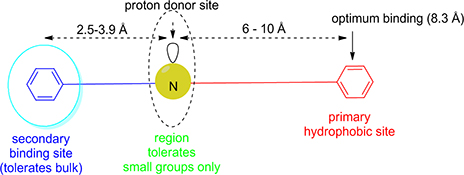
Sigma-1 receptor (S1R) is involved in a wide variety of central nervous system (CNS) diseases such as motor disorders, memory deficits, depression, schizophrenia, anxiety, pain, and drug addiction. This review focuses on recent developments in the generation of structurally diverse S1R-selective ligands and novel therapeutic candidates targeting S1Rs.
CH14531Epoxidation of trans-4-Aminocyclohex-2-en-1-ol Derivatives: Competition of Hydroxy-Directed and Ammonium-Directed Pathways
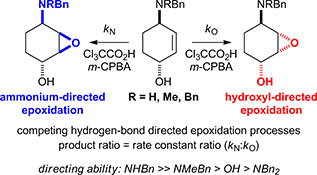
The epoxidation of a range of N-substituted trans-4-aminocyclohex-2-en-1-ols upon treatment with Cl3CCO2H followed by meta-chloroperbenzoic aid (m-CPBA) has been investigated. Competitive pathways resulting from hydrogen-bonding delivery by both the hydroxy group and the in situ formed ammonium ion are observed.
CH14596Consequences of Subtle Chiral Effects: From ‘Majority-Rules’ to ‘Minority-Rules’
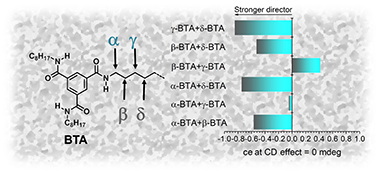
By mixing closely related chiral molecules, we have shown that in several combinations, the helical preference is governed by the minority compound.
CH14596 Abstract | CH14596 Full Text | CH14596PDF (481 KB) Open Access Article
CH14569Synthesis of Dichotomin A: Use of a Penicillamine-Derived Pseudoproline to Furnish Native Valine Residues
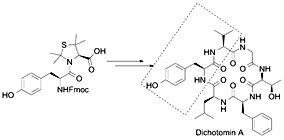
The naturally occurring cyclic peptide dichotomin A was synthesized using a penicillamine-derived pseudoproline to enhance the head- to-tail cyclization yield, followed by deprotection and desulfurization to give the native valine residue.
CH14526Reactivity of β-Diketiminato Magnesium Alkyl Complexes: Heterocumulenes and Phosphanes

Heteroleptic β-diketiminate/amidinate magnesium complexes {(BDI)Mg[MeC(NCy)2]} and {(BDI)Mg[BnC(NCy)2]} were synthesised. Rare terminal magnesium phosphanide complexes [(BDI)Mg(PR′2)(THF)] (R′ = Cy, Ph) were also generated.
CH14546Coordination of β-Ketoimine-Derived Ligands at Main Group and Transition Metals
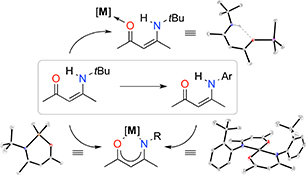
β-Ketoimines are used as a ligand source at main group and transition metal centres. The most common bonding mode is as the β-ketoiminate anion, which chelates with a k2O,N-coordination although an example of a neutral β-ketoimine with k1O-coordination has been structurally characterised.
CH14597The Interaction between Remote Chiral Centres: A Pseudoracemic Example
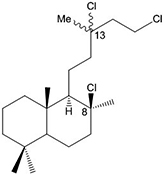
C13R or C13S? The historically important chlorinated derivative shown forms an unusual pseudoracemate via several synthetic routes and the ratio of diastereomers has been investigated.
CH14550EBC-316, 325–327, and 345: New Pimarane Diterpenes from Croton insularis Found in the Australian Rainforest
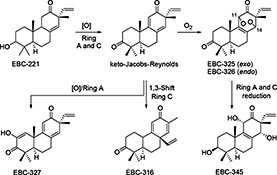
Five new pimarane-type diterpenes were isolated from Croton insularis, which grows in the northern Queensland rainforest.
CH14586Synthesis and Activity of Putative Small-Molecule Inhibitors of the F-Box Protein SKP2

Efficient syntheses of tetrahydropyran inhibitors of the F-box protein SKP2 have been developed, including both enantiomers of 4-(((3-(tetrahydro-2H-pyran-4-yl)-4-phenylbutyl)amino)methyl)-N,N-dimethylaniline, obtained using Evans’ chiral auxiliaries and which were shown to inhibit p27 degradation enantioselectively in a cell-based assay.
CH14513Synthesis of Novel Triazole-Containing Phosphonate Polymers
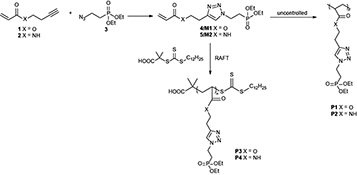
The main objective of this work was to develop novel phosphonate-containing polymers. Functionalized phosphines are one of the most attractive, yet under researched, classes of ligands that are capable of forming water-soluble transition metal complexes. It is envisaged that further experimentation will show the suitability of these polymers in aiding the aqueous solubility of a variety of metal complexes.

Several ketenes have been have been generated by flash vacuum thermolysis of 2-pyridylacetamide derivatives and isolated in Ar matrices for FT-IR spectroscopic characterisation, including methoxycarbonylketene, methoxycarbonyl(methyl)ketene, chloroketene, cyanoketene, diphenylketene, and 2-pyridylketene.
CH14530Facilitating Biomimetic Syntheses of Borrerine Derived Alkaloids by Means of Flow-Chemical Methods
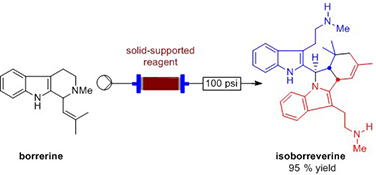
Flow chemistry, although now commonly used for general synthetic chemistry, has not been applied extensively in a biomimetic fashion. Here we show how the flow syntheses of borrerine derived alkaloids can use these principles to obtain complex architectures in a single step.
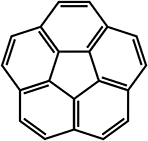
An intimate portrait of Sir John (‘Kappa’) Cornforth is presented to give an insight into the delightful multifaceted personality of one of Australia’s truly great people. In particular, it highlights his humanitarian wide-ranging intellectual and humorous character to conflate with his scientific genius and show that he was a Nobel Laureate without any airs or graces.



